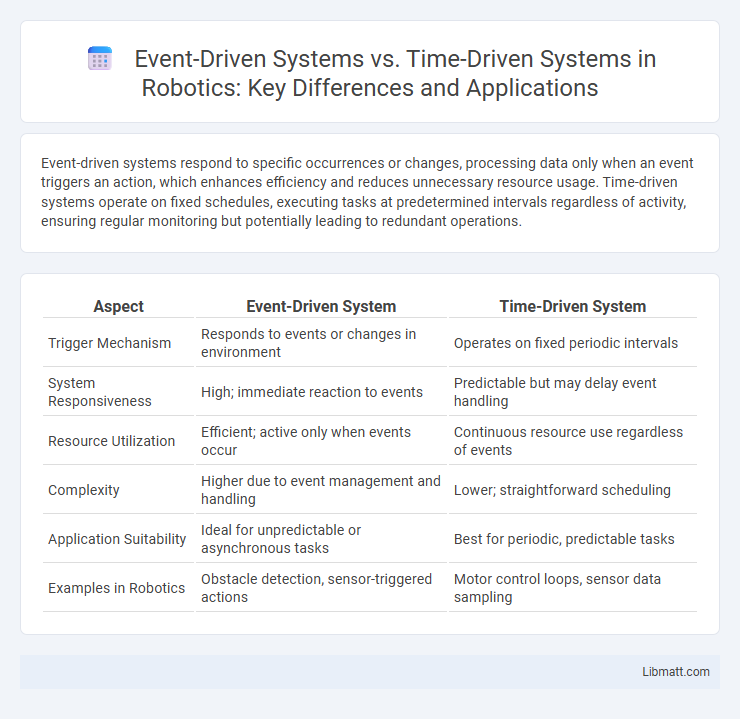Event-driven systems respond to specific occurrences or changes, processing data only when an event triggers an action, which enhances efficiency and reduces unnecessary resource usage. Time-driven systems operate on fixed schedules, executing tasks at predetermined intervals regardless of activity, ensuring regular monitoring but potentially leading to redundant operations.
Table of Comparison
| Aspect | Event-Driven System | Time-Driven System |
|---|---|---|
| Trigger Mechanism | Responds to events or changes in environment | Operates on fixed periodic intervals |
| System Responsiveness | High; immediate reaction to events | Predictable but may delay event handling |
| Resource Utilization | Efficient; active only when events occur | Continuous resource use regardless of events |
| Complexity | Higher due to event management and handling | Lower; straightforward scheduling |
| Application Suitability | Ideal for unpredictable or asynchronous tasks | Best for periodic, predictable tasks |
| Examples in Robotics | Obstacle detection, sensor-triggered actions | Motor control loops, sensor data sampling |
Introduction to Event-Driven and Time-Driven Systems
Event-driven systems operate based on the occurrence of specific events, triggering processes only when certain conditions are met or actions happen, which enhances system responsiveness and resource efficiency. Time-driven systems, in contrast, execute tasks at predefined intervals or scheduled times, ensuring regular and predictable operation regardless of external stimuli. Understanding these fundamental differences helps optimize system design by aligning processing strategies with application requirements and real-time constraints.
Core Concepts: Event-Driven Systems Explained
Event-driven systems operate by responding to specific events or changes in state, triggering processes only when necessary, which optimizes resource usage and enhances responsiveness. These systems rely on event producers, event channels, and event consumers to handle asynchronous data flow efficiently, making them ideal for real-time applications. Understanding this core concept helps you design applications that react dynamically to user actions, sensor inputs, or other unpredictable stimuli without continuous polling or wasteful processing.
Core Concepts: Time-Driven Systems Explained
Time-driven systems operate on predetermined schedules or fixed intervals, triggering processes based on specific time events rather than external inputs. Your system performs actions at regular, predictable moments, ensuring timely execution without waiting for external signals. This approach is ideal for applications requiring consistent periodic updates, such as automated backups or real-time monitoring dashboards.
Key Differences Between Event-Driven and Time-Driven Models
Event-driven systems respond to specific events or changes in state, triggering actions only when relevant occurrences happen, while time-driven systems execute tasks at predetermined time intervals regardless of external events. Event-driven models offer greater efficiency and responsiveness by processing data as it arrives, whereas time-driven models ensure regular updates and monitoring through fixed schedules. Your choice depends on whether system behavior needs dynamic adaptation to events or consistent, periodic execution.
Advantages of Event-Driven Systems
Event-driven systems offer enhanced responsiveness by processing tasks immediately upon event occurrence, reducing latency compared to time-driven systems that rely on fixed intervals. They optimize resource utilization since components activate only when needed, leading to improved efficiency and scalability. This adaptability makes event-driven architectures ideal for dynamic environments such as IoT, real-time monitoring, and user-interface applications.
Advantages of Time-Driven Systems
Time-driven systems offer consistent and predictable performance by executing tasks at predetermined intervals, which enhances reliability in real-time applications such as industrial automation and embedded control systems. These systems reduce complexity by avoiding the need for event detection and prioritization, leading to simpler design and easier debugging. Scheduled operation in time-driven architectures also ensures fair resource allocation and steady system behavior under varying workloads.
Typical Use Cases for Event-Driven Systems
Event-driven systems excel in real-time applications such as user interface interactions, sensor data processing, and financial trading platforms where immediate response to unpredictable inputs is critical. These systems are integral for IoT devices, monitoring systems, and asynchronous communication frameworks that rely on discrete events to trigger specific actions. Their design supports scalability and responsiveness, making them ideal for dynamic environments requiring rapid event detection and handling.
Typical Use Cases for Time-Driven Systems
Time-driven systems are commonly used in applications requiring periodic data sampling, such as real-time monitoring in industrial automation and control systems. These systems ensure consistent execution at fixed intervals, making them ideal for time-critical processes like embedded systems and scheduled data backups. Their deterministic timing enhances reliability in environments where predictability and synchronization are crucial.
Challenges and Considerations in Implementation
Event-driven systems face challenges in handling asynchronous data flow and ensuring real-time responsiveness under varying loads, requiring robust event management and fault tolerance mechanisms. Time-driven systems demand precise synchronization and scheduling to maintain timing accuracy, often complicating scalability and resource allocation. Both systems must balance latency, complexity, and scalability while addressing hardware limitations and integration with existing infrastructure.
Choosing the Right Model: Event-Driven vs Time-Driven
Choosing between an event-driven system and a time-driven system depends on your application's responsiveness and efficiency needs. Event-driven systems excel in environments requiring real-time reactions to unpredictable inputs, optimizing resource usage by processing only when triggers occur. Time-driven systems suit scenarios demanding regular, predictable operations, providing consistent performance through scheduled intervals.
Event-driven system vs Time-driven system Infographic

 libmatt.com
libmatt.com